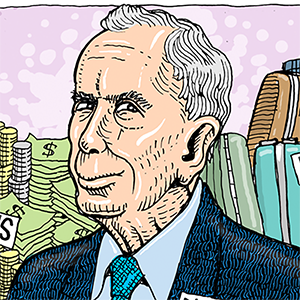Casey DeSantis touts Hope Florida as a way off welfare. But the state won't back up her claims
Published in News & Features
TALLAHASSEE, Fla. — For four years, Hope Florida, the passion project of First Lady Casey DeSantis, has boasted of saving millions of taxpayer dollars by weaning thousands of people off welfare and hooking them up with community organizations and religious nonprofits that can better serve their long term needs.
But the loosely-structured state program, seen as a springboard for the First Lady’s potential entry into politics, has failed to back up those claims of success or provide a full accounting of its finances despite repeated requests from the Orlando Sentinel and other news organizations.
Even legislative staffers have been unable to get answers about how many state workers and tax dollars have been diverted to Hope Florida from the state’s other programs to help residents in need of food, shelter, healthcare and work. That has irked House speaker Daniel Perez, who said at a meeting with reporters Friday he wouldn’t rule out using his subpoena powers.
Now, with legislation filed to shift Hope Florida from the oversight of the state’s Department of Children and Families to the Governor’s Office, the issue may be coming to a head.
A recent report from House legislative analysts — who work under the direction of Republican leadership — raises sharp questions about Hope Florida’s murky structure and rips into its nonprofit, charitable arm for failing to file federal tax returns, conduct an audit of its finances, or provide an ethics statement — all required by law.
“I want to make sure this organization is done the right way and totally above board before we codify this going forward,” Sen. Tina Polsky, D-Boca Raton, said during the bill’s first Senate committee hearing on Tuesday.
But Sen. Danny Burgess, a Zephyrhills Republican and close DeSantis ally, dismissed the concerns raised in the House analysis, saying they are “not the subject of the bill before us” in the hearing.
Gov. Ron DeSantis bristled at the suggestion of any wrongdoing. During a press conference Tuesday touting a new partnership between Hope Florida and county sheriffs, he blasted a reporter who asked why Hope Florida’s nonprofit arm, created to raise private donations to further its ostensible goals, was delinquent on its tax return.
“First of all, we’re not going to let you try to smear a good program with this stuff on these things,” DeSantis said, his wife at his side. “Since the First Lady launched this …. there have been 30,000 Floridians who have gotten off welfare programs and have saved the state about $100 million and so it’s good for taxpayers.”
DeSantis suggested the reporters’ questions originated with “House leadership.”
“I know the House is feeding you guys stuff. We weren’t born yesterday. We understand what they’re trying to do.” He added that the nonprofit would “take care of the paperwork.”
In an interview Thursday, Perez said those accusations were without merit, and that he wasn’t here to “curtail the future of Hope Florida.”
“I just want to make sure members have all the information at their disposal to make the right decision whether they want to vote up or down on a bill and we don’t have that from Hope Florida,” Perez said.
‘Grassroots’ effort depends on state resources
The DeSantises pitch Hope Florida as a grassroots antidote to bureaucratic bloat and an alternative to the cycle of dependency on government assistance.
“When somebody is in need of help do you get a government check and that’s where the story ends?” Casey DeSantis asked at the Tuesday press conference. “Or can we help you on the pathway to economic self sufficiency? Can we provide a lifeline of hope the solution is not the government?”
But it has absorbed staff and resources from nearly a dozen state agencies, primarily DCF, in pursuit of its mission.
Hope Florida has its roots in a pilot project launched by DCF in 2020 to use what it called “care navigators” to connect people receiving food stamps and welfare with community organizations able to help them.
It started off with 30 full-time care navigators, or counselors, in northwest and central Florida and has since grown to include 125 staffers, renamed Hope Navigators, across 11 state agencies, including Juvenile Justice, the Agency for Health Care Administration, CareerSource, Education, Veterans Affairs, Elderly Affairs and the Guardian Ad Litem program, which represents children in domestic violence situations.
These navigators link impoverished Floridians with the network of religious and community organizations that support them and teach them how to take of themselves, according to Hope Florida’s supporters.
Casey DeSantis has no formal role with Hope Florida, although she has regularly been its public champion. Instead it is overseen by a $108,000-a-year DCF supervisor, Dawn Murray, but a fuller picture of its finances is nowhere to be found in the state budget. Only pieces of its spending have previously come to light.
In 2023, the Legislature authorized $1.25 million for 14 Hope Florida positions — including $324,370 for five positions in Elder Affairs; $431,351 for four positions in Veterans Affairs; and $496,966 for five additional positions elsewhere.
Beyond that, House analysts said some number of Hope Florida jobs came by reassigning staffers or vacancies from other agencies, mainly DCF, but it could not determine how many positions “were repurposed for Hope Florida functions” nor how many state employees are actually working for Hope Florida.
“Similarly, the extent to which participating state agencies have entered into contracts for goods or services to further the Hope Florida mission is also unknown,” the House analysis said.
Gov. DeSantis is now asking the Legislature for $536,792 to create four new positions and move Hope Florida under his own executive offices. The House has no funding for those positions in its proposed 2025-26 state budget, but the Senate does, as well as $2 million to fund a Hope hotline at DCF that directs applicants to services.
In the Senate hearing, Burgess repeated the administration’s claims of Hope Florida’s success.
“We saved $108 million by supporting people with opportunities that are truly changing their lives without a temporary bridge,” Burgess said. “They’re a force multiplier.”
The House staff analysis said DCF has provided no documentation to back up those numbers, despite repeated requests. A DCF analysis of the bill said the savings were estimated by calculating the monthly benefits that had been received by 30,000 people it cut from the food stamps and welfare programs.
But those programs are funded from federal tax dollars, not state, leaving unclear where the state savings come in.
Questions about donations
Questions are also being raised about the private donations Hope Florida has collected through its nonprofit arm, which furnishes the money behind the over-sized checks Casey DeSantis has handed out to religious groups that worked with Hope Florida over the last few years.
DCF has not provided records of private donations, how that money was being distributed, or what criteria was being used to decide who gets that funding. House analysts also were stonewalled.
Department of Education records, however, show that it has funneled nearly $1.3 million from its own nonprofit arm, the Florida Education Foundation, to something it calls the “Hope Florida Fund.”
“The Florida Education Foundation is authorized to award expedited grants to support education related initiatives and has accepted donations with donor intent to go towards the Hope Florida Fund and support education initiatives,” DOE spokesperson Sydney Booker said in a December email to the Sentinel.
DCF currently has the legal responsibility for managing Hope Florida’s charitable arm. The Legislature created the nonprofit Hope Florida Foundation in 2023 for the “sole purpose” of carrying out the agency’s mission to help children. That includes addressing gaps in services for the children and adults served by the department, developing prevention efforts and providing other services and activities, the statute says.
A key reason the Foundation’s revenues since then are unknown is that it apparently has not filed its tax returns. A search on the IRS website came up empty, nor could tax returns be found on GuideStar, an online clearinghouse of nonprofit organizations, or on ProPublica’s nonprofit explorer.
The Foundation also hasn’t submitted an annual audit that was due March 31.
Polsky said she is struggling to understand what distinct role Hope Florida is serving amid multiple other state agencies tasked with helping needy Floridians.
“We talk about government efficiency, but it doesn’t make sense to have agencies working at cross purposes without falling all over each other,” Polsky said. “We should DOGE it up and have one organization overseeing this and not have multiple groups going at it from different directions.”
Rep. Anna Eskamani, D-Orlando, said she appreciated the efforts of Hope Florida’s supporters to bolster its operations through legislation, but still had concerns about diverting resources from state services already struggling to serve the needs of the growing number of residents in crisis.
“A lot of our offices every day get calls from constituents navigating the broken safety net with its unemployment, food stamps, (welfare), rental assistance that is not to be found in this state,” Eskamani said. “We want to help families be economically self-sustaining but there are so many gaps in that system. We are all trying to help families.”
-------------
©2025 Orlando Sentinel. Visit at orlandosentinel.com. Distributed by Tribune Content Agency, LLC.







Comments